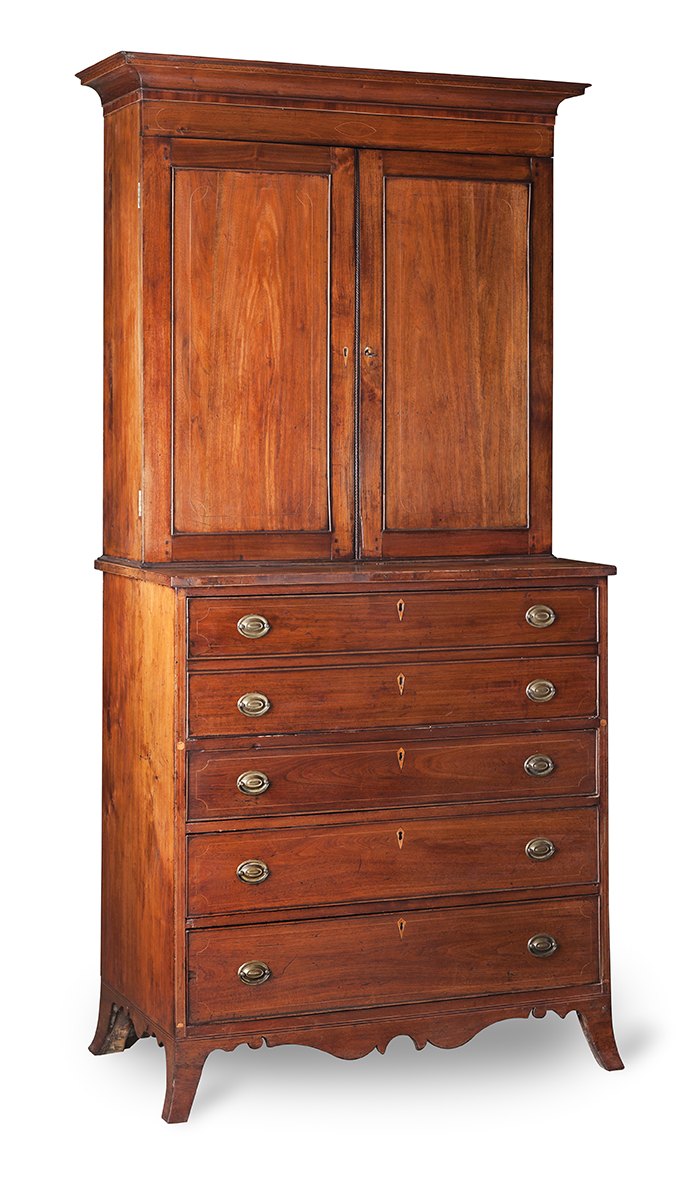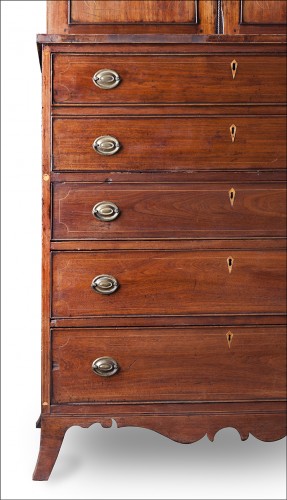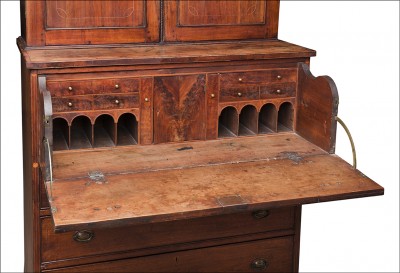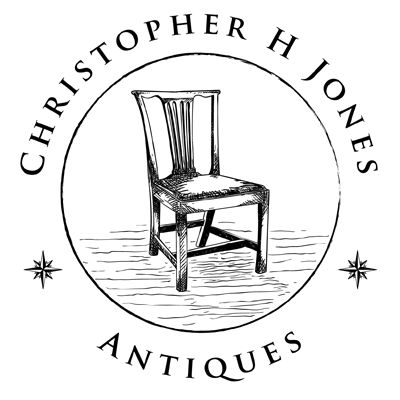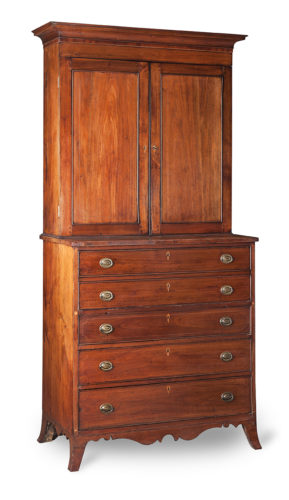
Federal Secretary and Bookcase in a fine, old surface
Walnut with extensive light string inlay
Upper Potomac River Valley of Maryland or Virginia
Circa 1810
This finely crafted secretary and bookcase is a superb example of the interpretation of the Federal style in the rapidly expanding interior regions of the upper Potomac River valley. As settlement pushed west from the coastal cities after the turn of the 19th century, the population of the emerging towns of Harpers Ferry, Shepherdstown and Martinsville, West Virginia and Frederick, and Hagerstown in Maryland supported multiple cabinetmakers.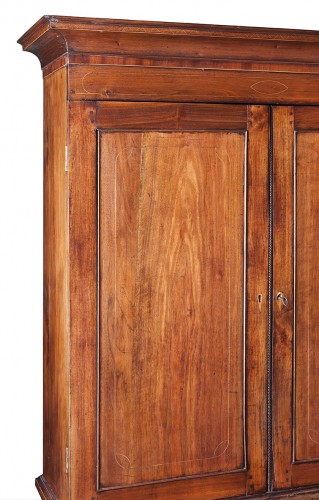
One such cabinetmaker that typifies the group is Charles Cameron (1788–1865) from Shepherdstown, West Virginia. Cameron likely learned the cabinetmaking trade from Scottish born Daniel Cameron (b. 1753, Perth, Scotland; d. 1805 Shepherdstown), perhaps his father or uncle who was a carpenter or cabinetmaker.
Two signed pieces of Cameron’s work have been documented: a chest of drawers dated 1808 in the photographic collection at Winterthur and a cylinder desk in the collection at MESDA. On the basis of these two pieces, a third, a secretary and bookcase in the collection of Colonial Williamsburg, has been attributed to Cameron.[1]
Both aesthetically and structurally these Cameron objects closely relate to the secretary and bookcase under discussion and illustrate a story of cabinetmaking in the upper Potomac region at the time. The use of imported mahogany for the veneers, the decorative inlays, the shaped skirts and elegant French feet, and the sophisticated interiors of the secretary drawer all reflect the influence of Baltimore neoclassical designs on backcountry fashions. Indeed, Swift & Conway, a cabinetmaking firm in Charles Town informed their customers in 1813 that: “the concern has lately visited Baltimore for a supply of materials and viewing the present fashions.” (Farmer’s Repository Charles Town, West Virginia, December 9, 1813, vol. VI, issue 298, p. 4).
George Hepplewhite described this form of desk with a secretary drawer (Plate 44 of his Gentleman and Cabinet-Maker’s Guide; 1788) as a “Secretary and Bookcase” which distinguished it from a slant front desk and bookcase. This form with a flat projecting cornice and French feet and shaped skirt was very popular in Baltimore and several examples have been attributed to Baltimore’s preeminent Federal era cabinetmaker, William Camp (active 1801-1822).[2]
However, the construction and proportions of these objects reveals their more provincial origins. The extreme verticality of the desk would suggest that the desk was made by a Scots-Irish cabinetmaker rather than one working from German aesthetic preferences that tended to be more robust, broad and heavy. Cherry and walnut wood was used for the carcasses. The use of several secondary woods – pine, poplar and walnut — also reinforces the supposition that the desk was made by a rural shop where typically artisans used whatever woods were at hand. and the heavy, four sided drawer frames are more typical of backcountry rather than Baltimore work. The unconventional inlay patterns and exuberant styling of the apron on the secretary are a local interpretation of Baltimore fashion. There is such a variety of decoration on the desk including a number of different inlay patterns (sawtooth, arcs facing in and out, lozenges, circles and half circles) and veneers that it is clear the maker was not constricted by a strict decorative program a more urban shop might impose.
Several construction details that appear in this desk also appear in other objects from the region. Rather than mortise and tenon construction the side drawer supports are tenoned into the front rail and rear support case via a relatively short dado in the front and back blades that allows the side blades to slide into place. Secondly, the top bookcase sits on top of the lower case rather than sliding into a recessed section. The small coved waist molding on the upper case is nailed to runners which are nailed to the bottom board. The upper case was secured with screws to the lower case.
Both the documented examples of Cameron’s work and this secretary illustrate the aspirations of clientele in the backcountry regions for furnishings of the latest style as interpreted by local cabinetmakers with more limited resources and exposure than their urban counterparts.
Little is known of Cameron’s cabinetmaking career, but by 1821 Cameron appears to be living in nearby Harper’s Ferry and working for the rifle works at the armory there; no doubt a more lucrative and steady occupation. He purchased several lots in the Bolivar Heights section of town, an area where many of the skilled armory workers put down roots. In the 1850 Census, Cameron, age 62, is still listed as an armorer at Harper’s Ferry.
The secretary and bookcase descended in the Kline-Ellis family, long time residents of Frederick, Maryland and was purchased at the estate sale of Charlotte Ellis in 2008. Charlotte Kline Ellis lived and died in the home of her parents on East Third Street in downtown Frederick. Charlotte Kline’s great-great grandfather, Stephanus or Stephan Klein, originally from York County, Pennsylvania married Eva Schultz in Frederick in 1790 and was possibly the original owner of the secretary and bookcase. Stephanus moved his bride over the Catoctin Mountains west to the Middletown valley in the same year as the first of their children was baptized at the Evangelical Lutheran Church in Middletown later that same year. (The rest of their 10 children were baptized in Middletown as well). Middletown was a trading town that developed after the establishment of the National Turnpike – the superhighway for settlers moving west from Philadelphia and Baltimore in search of land. The unending flow of Conestoga wagons fueled the local economy and the Turnpike connected Middletown with the major cities of the east as well as the burgeoning towns located further west in Maryland and Virginia.
Price: sold
[1] See Hurst and Prown, Southern Furniture, 1680-1830, catalog no. 143.
[2] See Gregory R. Weidman, Furniture in Maryland 1740-1940, plate 96; also Miller, Edgar G., Jr. American Antique Furniture, A Guide for Amateurs, 2 vols., catalog numbers 859, 957, 959, and 860; Baltimore Furniture: The Work of Baltimore and Annapolis Cabinetmakers from 1760 to 1810, catalog number 76 and Marilyn Johnson Bordes, Baltimore Federal Furniture NY: The Metropolitan Museum of Art, 1972, catalog number 2).

